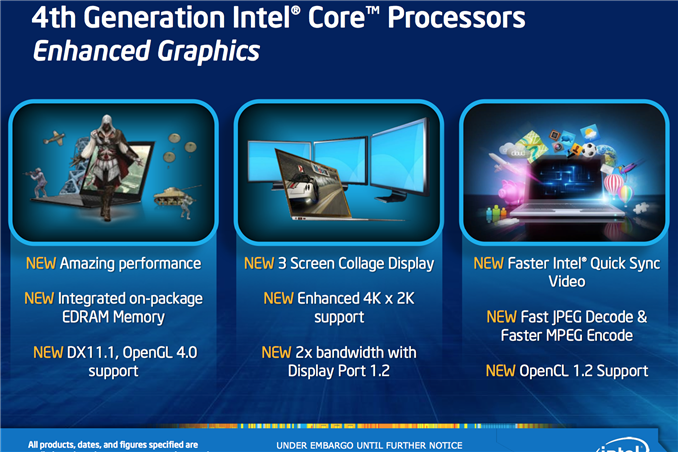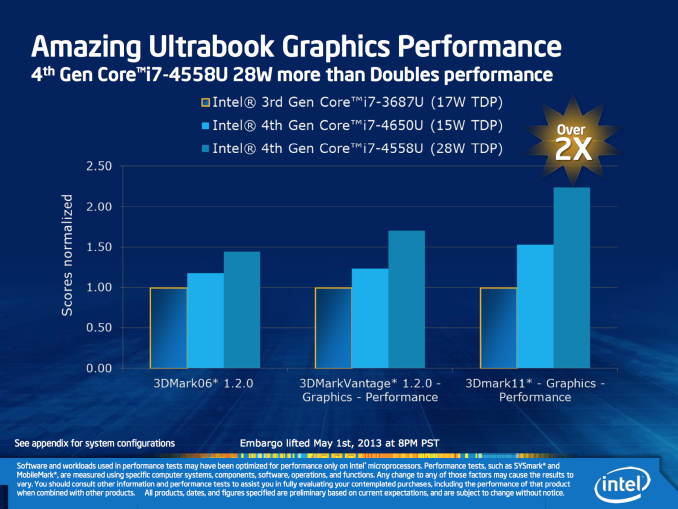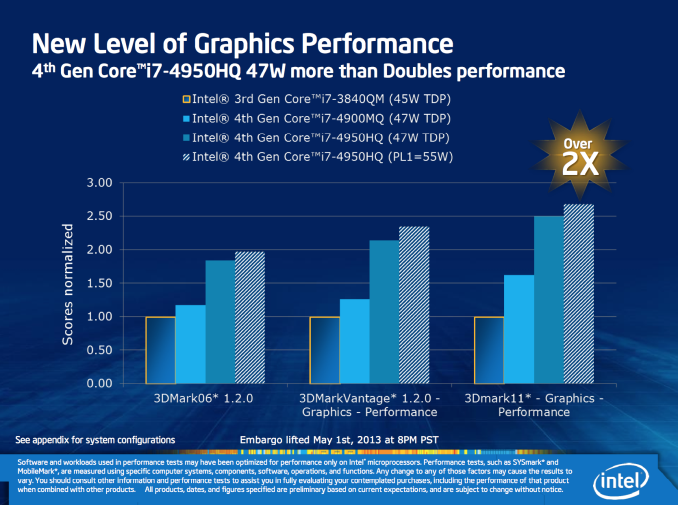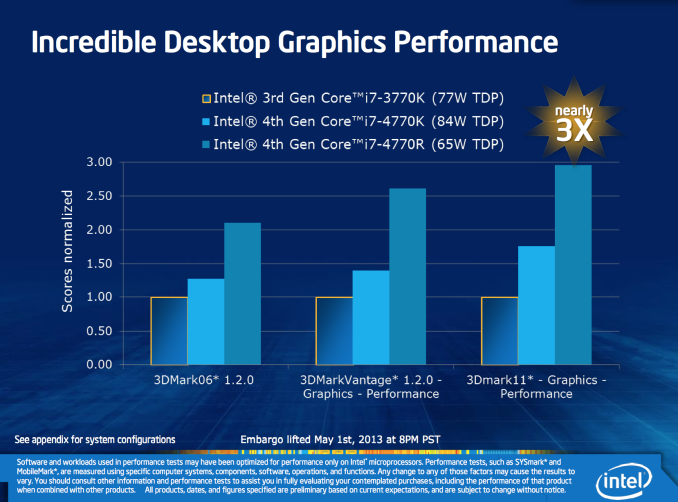Intel Iris & Iris Pro Graphics: Haswell GT3/GT3e Gets a Brand
by Anand Lal Shimpi on May 1, 2013 11:00 PM EST
We’ve known for a while that Intel’s Haswell processor would continue to drive GPU performance in a significant way. With Haswell, Intel will offer a higher end graphics configuration with more execution resources than before (GT3) as well as an even higher end offering that pairs this GPU with 128MB of embedded DRAM on the CPU package (GT3e). Intel’s performance target for the highest end configuration (GT3e) is designed to go up against NVIDIA’s GeForce GT 650M, a performance target it will hit and miss depending on the benchmark.
Regardless of whether or not it wins every benchmark against the GT 650M, the fact that an Intel made GPU can be talked about in the same sentence as a performance mainstream part from NVIDIA is a big step forward. Under no circumstances could Intel compete with NVIDIA on performance and still do so under the Intel HD Graphics brand. Haswell is the beginning of a new era for Intel. The company is no longer a CPU company forced into graphics, but with Haswell Intel begins its life as a GPU company as well. As a GPU company, Intel needs a strong GPU brand. AMD has Radeon, NVIDIA has GeForce, and now Intel has Iris.
The brand is a nod to a long forgotten history of 3D graphics, as well as an obvious reference to the fact that GPUs are used for very visual purposes. Before OpenGL was well, open, it was a project known as IrisGL.
Intel is doing the right thing with Iris and only using it to refer to its absolute best graphics options. Intel HD Graphics will remain, and will refer to all GT1/GT2 and some GT3 configurations with Haswell. Iris and Iris Pro will be used to refer to high end GT3 and GT3e configurations:
Anything with GT3e will have Intel’s Iris Pro 5200 graphics, while 28W SKUs with GT3 will have vanilla Iris 5100 (non-Pro). Any 15W SKUs with GT3 will be HD Graphics 5000, and GT2/GT1 parts will also be identified as Intel HD Graphics.
We know what makes Iris Pro special (128MB of eDRAM), but it appears that the main difference between Iris 5100 and HD 5000 is max GPU clock speed. Intel wants Iris associated with performance, which is a very good thing. Having Iris reach down into non-GT3e parts as well is a bit unsettling but at least GT3e gets the Pro designation.
Intel claims Iris/Iris Pro will deliver up to 2x better performance than Intel’s HD 4000 graphics in notebooks, and it’s using 3DMark11 to validate that claim:
Although Ultrabooks (now 15W) won’t get full blown Iris performance, they should still see a healthy increase in GPU performance compared to where they are today (50% improvement in 3DMark) at a lower TDP. The move to a full speed GT3 part (Iris) should more than double performance in 3DMark. Also worth noting is the fact that we now have a 28W ULT part (i7-4558U). This is a part designed for larger Ultrabooks (14/15"+) that would otherwise have a low end discrete GPU.
Iris Pro will be exclusive to quad-core parts, and the advantage there grows to 2.5x in 3DMark11. There's a slight increase in processor TDP here, but obviously much better performance. That last bar is with the i7-4950HQ running with its TDP set to 55W (cTDP up).
BGA (non-socketed) desktops will also have the option of using Iris Pro if you get an R-series SKU. The performance gains there over Intel HD 4000 are even more impressive thanks to the additional TDP headroom:
QuickSync performance will also improve as a function of increased number of EUs. There’s also DX11.1, OpenCL 1.2, OpenGL 4.0 and 4Kx2K support.
This is really the beginning of a new era. Intel isn't talking specifics about power savings here, but that's really where Iris and Iris Pro will shine. The fact that performance will finally be reasonable enough to actually play games is just icing on the cake. Kicking discrete GPUs out of non-gaming focused notebooks and replacing them with Iris Pro parts should keep performance high while significantly reducing power consumption.
With Iris Intel is finally committed to graphics, and that's a very good thing.















104 Comments
View All Comments
karamazovmm - Saturday, May 4, 2013 - link
Not really you forgot that nvidia couldnt do chipsets for core i series.JDG1980 - Thursday, May 2, 2013 - link
I'm curious as to what this improvement means in real-world terms. For example, I currently have a fairly modest discrete card (Radeon HD 5670) which I use for some light gaming. How will Iris Pro 5200 compare to this and other older graphics cards? At what point is a discrete card still needed?Spunjji - Friday, May 3, 2013 - link
You'll need to wait for benchmarks to figure that one out for sure. 3DMark results don't scan well to real-world performance, particularly with Intel GPUs. At a guess, however, I'd say the performance should be comparable if you were prepared to accept some image quality compromises.Quizzical - Thursday, May 2, 2013 - link
Only OpenGL 4.0 and not 4.3 like AMD and Nvidia offer? Is Intel ever going to try to catch up on API support?makerofthegames - Thursday, May 2, 2013 - link
Does anyone see Intel moving into the discrete GPU market?I don't think it would be too hard for them at this point. It would basically just be a GT3 or GT3e with yet more execution units, something like 80, 120, maybe 160 EUs, and with a dedicated memory controller and memory (probably ripped from the GDDR5 of the Xeon Phi).
Intel's definitely shown interest in desktop graphics (the aforementioned Xeon Phi was, at one point, going to be a consumer graphics card). And they have most of the parts they need now to finish one up.
I don't think they're going to be jumping into the top-end market just yet, but I could see them continuing to eat up the low-end market, maybe competing with AMD's 77xx cards, or up to Nvidia's GTX 660.
jeffkibuule - Thursday, May 2, 2013 - link
Even if they made the part, would anyone buy it? Who would spend $200+ on an Intel GPU when their driver performance is subpar?makerofthegames - Thursday, May 2, 2013 - link
Are they really that bad? They're consider by far the best on Linux, and on Windows I've heard far more complaints about AMD drivers than Intel, although that may have more to do with most people who care about graphics not using Intel.tipoo - Friday, May 3, 2013 - link
"may have more to do with most people who care about graphics not using Intel."Yup, answered your own question. AMD drivers are a dream compared to Intel, even in 2013.
Spunjji - Friday, May 3, 2013 - link
Haha, yeah, not even the same ballpark under Windows. It's an issue of scale. AMD drivers are (on average) a little worse than nVidia (with many glaring and complicated exceptions on either side), while Intel are a LOT worse. We're talking fun issues like games not running at all and/or severe graphical glitches.xdrol - Thursday, May 2, 2013 - link
That's nonsense. The market is moving towards integrated graphics, not discrete one.